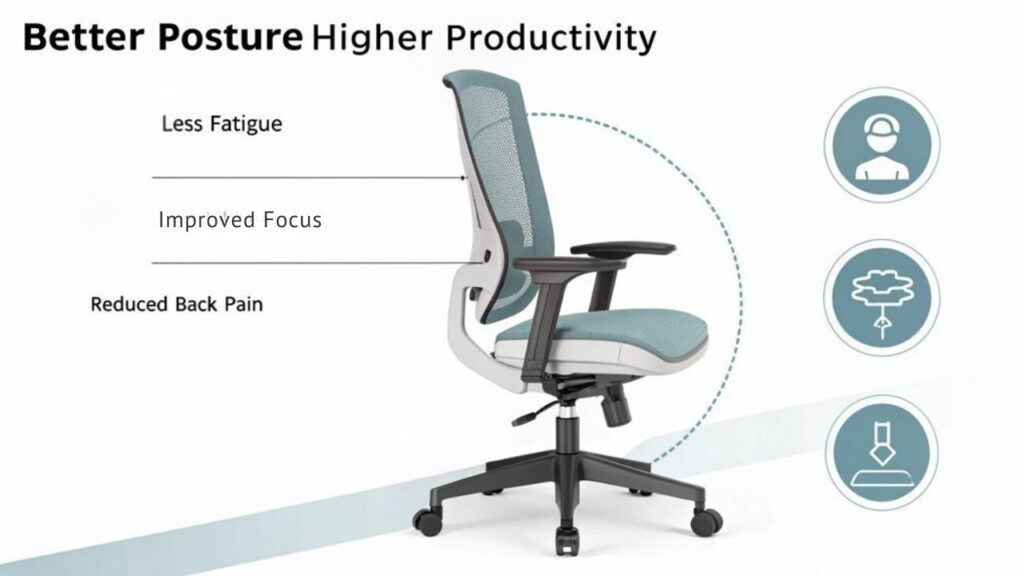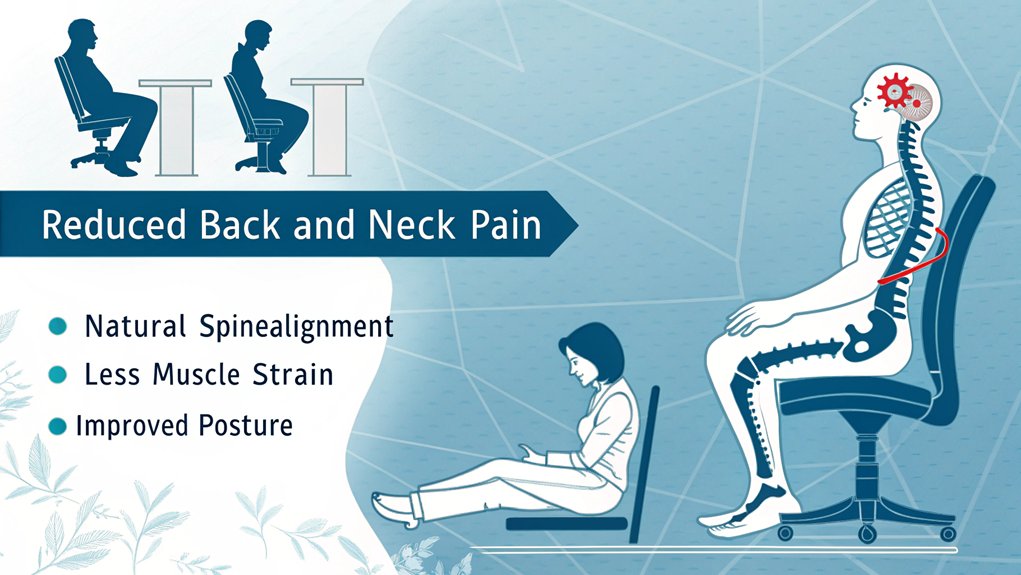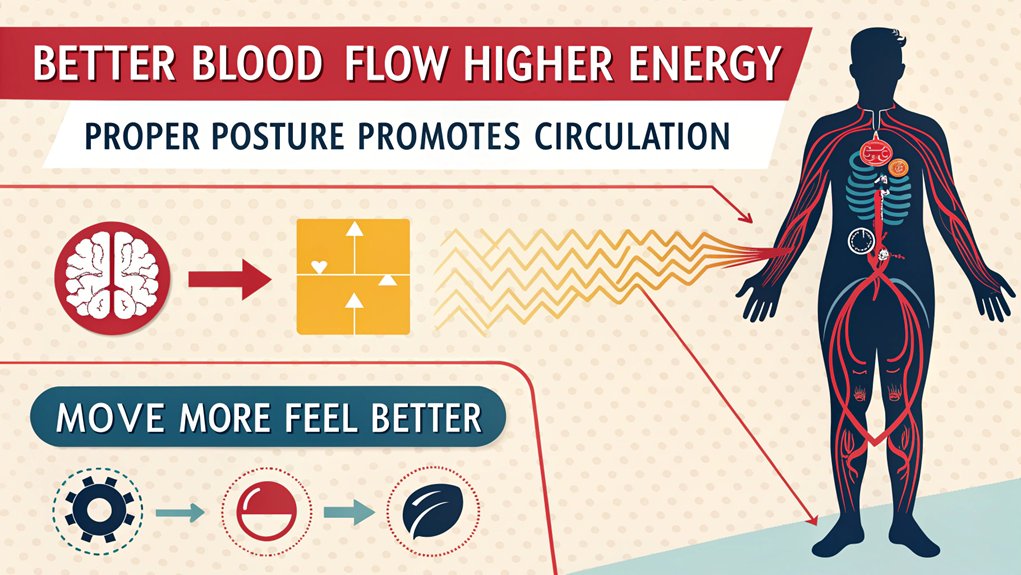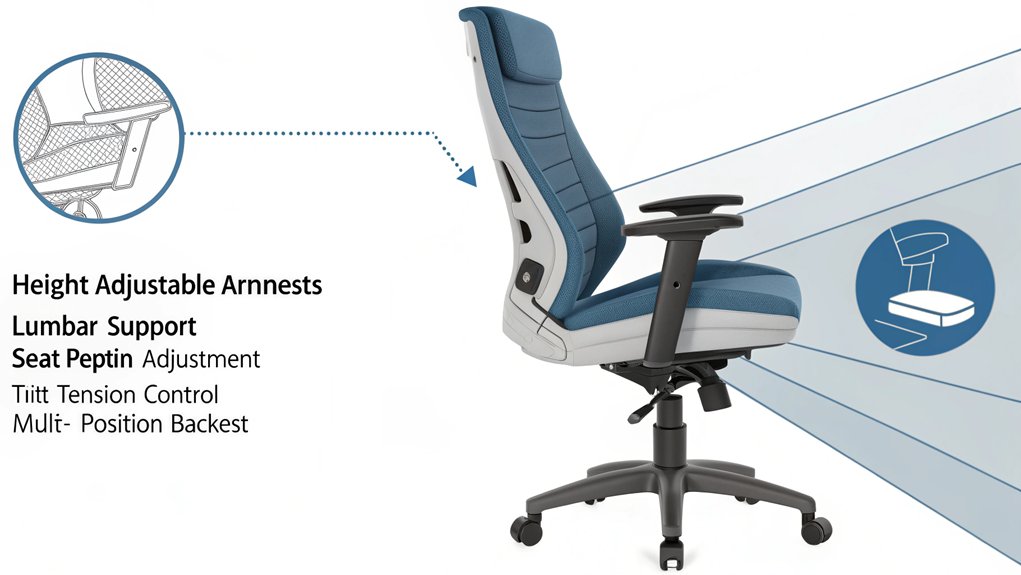You’ve likely experienced the discomfort of sitting in a standard office chair for hours, leading to stiffness, pain, and reduced focus. Ergonomic seating represents a significant advancement in workplace comfort and health, offering scientifically-designed features that align with your body’s natural posture. From adjustable lumbar support to customizable seat depth, these chairs deliver measurable benefits that extend far beyond basic comfort. Let’s examine the key advantages that make ergonomic seating a worthwhile investment.
Key Takeaways
- Ergonomic seating promotes proper spinal alignment and reduces back pain by supporting the natural S-curve of the spine.
- Adjustable features accommodate individual body types and preferences, ensuring optimal comfort during long work hours.
- Enhanced blood circulation and unrestricted limb movement help maintain energy levels and prevent muscle fatigue.
- Cushioned support and weight distribution minimize pressure points and physical strain on specific body areas.
- Companies benefit from increased productivity and reduced healthcare costs due to fewer workplace injuries and sick days.
Better Posture and Spinal Alignment
Although traditional office chairs can provide basic support, ergonomic seating promotes ideal spinal alignment through its adjustable features and evidence-based design principles.
You’ll find that dynamic seating configurations allow your spine to maintain its natural S-curve while accommodating your body’s need for micro-movements throughout the day.
Modern workplace design emphasizes the importance of customizable lumbar support and seat depth adjustments that match your unique physical proportions.
These ergonomic features help prevent the forward head posture and rounded shoulders that often result from prolonged sitting.
You can fine-tune the chair’s tilt mechanism, armrest position, and seat height to create optimal angles for your joints, reducing compression on your spinal discs and maintaining healthy alignment of your pelvis, thoracic spine, and cervical vertebrae.
Increased Comfort and Productivity

The direct correlation between ergonomic seating and workplace productivity stems from enhanced physical comfort and reduced musculoskeletal strain. You’ll notice significant improvements in your work output when your chair’s ergonomic design supports proper positioning throughout the day.
Advanced seating materials distribute your body weight evenly, reducing pressure points and fatigue during long work sessions. This targeted support allows you to maintain focus on tasks rather than shifting constantly to find comfortable positions.
The ergonomic design elements, including adjustable armrests, seat depth, and lumbar support, work together to create a personalized fit that minimizes physical stress. By eliminating discomfort-related distractions, you’re able to sustain higher concentration levels and maintain consistent productivity throughout your workday.
Reduced Back and Neck Pain

Your spine naturally seeks proper alignment, and ergonomic seating works to maintain this ideal position throughout your workday.
When you sit in an ergonomic chair, you’ll notice how it guides your vertebrae into a healthy S-curve while supporting your lumbar region.
This natural posture reduces strain on your muscles and ligaments, allowing you to maintain comfortable positioning without conscious effort.
Proper Spinal Alignment
Maintaining proper spinal alignment through ergonomic seating directly impacts musculoskeletal health and reduces chronic pain conditions.
When you sit in an ergonomic chair, it supports your spine’s natural S-curve, promoting ideal positioning from your cervical vertebrae down to your lumbar region.
The ergonomic design features adjustable components that you’ll integrate to match your unique spinal curvature.
You’ll find that the chair’s synchronized tilt mechanism adapts to your movements, maintaining proper alignment even as you shift positions.
The adjustable lumbar support guarantees your lower back remains in a neutral position, while the dynamic backrest accommodates your natural spine mechanics.
Supporting Natural Posture
When properly configured, ergonomic chairs facilitate natural posture by distributing body weight evenly across key support points.
You’ll notice immediate benefits as the chair’s adaptive design works with your body’s natural curvature, particularly in maintaining ideal spinal positioning throughout your workday.
The chair’s integrated pelvic support helps prevent slouching by stabilizing your lower back and promoting upright sitting.
This targeted support reduces pressure on your spine and surrounding muscles, allowing you to maintain proper posture without conscious effort.
Advanced ergonomic models feature synchronized tilt mechanisms that automatically adjust to your movements, ensuring continuous support as you lean forward or recline.
Enhanced Blood Circulation and Energy Levels

Proper ergonomic seating enables you to move your limbs freely while maintaining ideal posture at your workstation.
Your unrestricted movement, combined with correct seat height and positioning, promotes healthy blood circulation throughout your legs and arms during extended work periods.
The enhanced blood flow to your extremities helps maintain higher energy levels and reduces the risk of circulation-related discomfort that typically occurs with prolonged sitting.
Limb Movement Benefits
The ergonomic positioning of limbs in well-designed seating directly impacts blood circulation throughout your body. When you’re seated in an ergonomic chair, your joints maintain ideal angles that promote both joint flexibility and muscle relaxation.
The chair’s design enables natural movement patterns that reduce strain on your muscles and ligaments.
- Your legs can move freely without compression points that restrict blood flow
- Your arms rest at angles that prevent shoulder and elbow tension
- Your feet maintain proper contact with the floor or footrest, supporting lower limb circulation
- Your knees bend at approximately 90 degrees, reducing pressure on your thighs
These movement benefits prevent stiffness and fatigue while supporting your body’s natural need for micro-adjustments throughout the day.
The dynamic design allows you to shift positions effortlessly while maintaining proper alignment.
Blood Flow During Work
By maintaining ideal blood circulation during work hours, ergonomic seating helps sustain your energy levels and cognitive performance throughout the day. Proper ergonomic design promotes active sitting positions that prevent blood pooling in your legs and feet, while supporting natural spine alignment.
| Blood Flow Benefits | Work Environment Impact |
|---|---|
| Reduced leg swelling | Enhanced productivity |
| Improved oxygen delivery | Decreased fatigue |
| Better nutrient distribution | Increased focus |
| Enhanced metabolic function | Sustained energy |
You’ll experience improved circulation through features like waterfall-edge seats that reduce pressure on your thighs and adjustable seat depths that accommodate your unique body proportions. When your blood flows efficiently, you’re less likely to experience the afternoon energy slumps common in traditional office settings, helping you maintain peak performance in your dynamic work environment.
Customizable Support Features

Modern ergonomic chairs incorporate numerous customizable support features that adapt to individual body types and working preferences.
You’ll find extensive adjustment capabilities that let you fine-tune your seating position for ideal comfort and support throughout your workday. The adjustable lumbar support allows you to target specific areas of your lower back, while precise seat height controls enable proper positioning relative to your desk.
- Multi-axis armrests that adjust in height, width, and pivot angle
- Synchronized tilt mechanisms that maintain ergonomic angles during recline
- Seat pan depth adjustment to accommodate different leg lengths
- Dynamic tension controls that adapt to your body weight and movement patterns
These customization options guarantee your chair provides personalized ergonomic support that evolves with your changing needs and work habits.
Long-term Health Benefits and Cost Savings

Investing in ergonomic seating delivers measurable returns through reduced healthcare costs and improved workplace productivity. You’ll find significant long-term financial implications when implementing preventive care strategies through proper seating solutions.
| Health Benefit | Cost Savings |
|---|---|
| Reduced musculoskeletal disorders | Lower medical claims |
| Decreased absenteeism | Increased productivity |
| Better posture maintenance | Reduced worker compensation |
Frequently Asked Questions
How Long Should I Sit in an Ergonomic Chair Before Taking Breaks?
You’ll want to limit your seating duration to 30-45 minutes at a time, with break frequency of 2-5 minutes between sessions to maintain ideal posture and circulation.
Can Ergonomic Chairs Help With Existing Medical Conditions Like Herniated Discs?
Like a scaffold supporting a healing structure, ergonomic chairs can offer herniated disc relief through proper spine alignment. You’ll find targeted support benefits, though you’ll still need professional medical guidance for complete treatment.
What Is the Average Lifespan of a Quality Ergonomic Office Chair?
You’ll get 7-10 years from a quality ergonomic chair if you maintain the chair materials properly. Regular cleaning, lubrication, and tightening of components extend its lifespan considerably.
Are Gaming Chairs Considered Proper Ergonomic Seating Options?
While gaming chairs offer aesthetic appeal, they don’t provide ideal ergonomic design benefits. You’ll find better posture support and adjustability in professional office chairs designed specifically for long-term workplace comfort.
How Do I Properly Adjust My Ergonomic Chair for Maximum Benefits?
Like fine-tuning a precision instrument, start by adjusting your seat height so feet rest flat. Position lumbar support to match your spine’s curve, keeping thighs parallel and arms at keyboard level.
Conclusion
You’ll find that ergonomic seating, much like the carefully engineered chairs of the Victorian era’s industrial revolution, represents a quantum leap in workplace optimization. By investing in these scientifically designed seats, you’re securing both immediate comfort and long-term health benefits. The customizable features, enhanced circulation, and proper spinal support create a synergistic effect that maximizes your productivity while minimizing physical strain and potential healthcare expenditures.

I am a retired software engineer with experience in a multitude of areas including managing AWS and VMWare development environments. I bought a relative a mini-PC a year ago and have become passionate about the technology and its potential to change how we deploy software.

